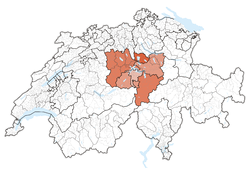Central Switzerland
In today's world, Central Switzerland is a topic that has sparked great interest and debate in various areas of society. From its impact on the economy to its influence on popular culture, Central Switzerland has become a central point of discussion. As we move into the 21st century, it is crucial to understand and analyze the role of Central Switzerland in our lives, both individually and collectively. This article explores the various facets and perspectives related to Central Switzerland, addressing its relevance and scope in today's world.
Central Switzerland
Zentralschweiz | |
|---|---|
Region | |
 | |
| Country | |
| Area | |
| • Total | 4,483.3 km2 (1,731.0 sq mi) |
| Population | |
| • Total | 718,400 |
| • Density | 160/km2 (420/sq mi) |
| NUTS code | CH06 |
| HDI (2018) | 0.939 very high · 5th |
Central Switzerland is the region of the Alpine Foothills geographically the heart and historically the origin of Switzerland, with the cantons of Uri, Schwyz, Obwalden, Nidwalden, Lucerne and Zug.
Central Switzerland is one of the NUTS 2 statistical regions. As such it includes the cantons of Lucerne, Uri, Schwyz, Obwalden, Nidwalden, Zug.
See also
![]() Media related to Zentralschweiz at Wikimedia Commons
Media related to Zentralschweiz at Wikimedia Commons
References
- ^ "Total area and land area, by NUTS 2 regions - km2".
- ^ "Total average population, by NUTS 2 regions - (1 000 inhabitants)".
- ^ "Sub-national HDI - Area Database - Global Data Lab". hdi.globaldatalab.org. Retrieved 2018-09-13.